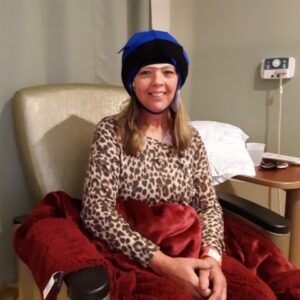10 things you should know about hair loss after chemo
Published: August 3, 2023
 If you need chemotherapy as a part of your cancer treatment, you might have some concerns about losing your hair. But does every chemotherapy drug cause hair loss? And is there anything you can do to prevent this possible side effect?
If you need chemotherapy as a part of your cancer treatment, you might have some concerns about losing your hair. But does every chemotherapy drug cause hair loss? And is there anything you can do to prevent this possible side effect?
Most hair loss during cancer treatment is caused by chemotherapy. That’s because chemo targets rapidly growing cells, which damages hair follicles and makes the hair fall out. But radiation therapy can sometimes cause hair loss, too, when it’s used to treat head and neck cancers. It depends on the area that’s receiving radiation.
1. Do all chemotherapy drugs cause hair loss?
No, not all chemotherapy drugs have hair loss as a possible side effect, but some are stronger than others. Check with your care team to find out if it’s a potential side effect of the drugs you’ll be taking.
2. Will every patient who receives chemotherapy lose their hair?
Success largely depends on the type of chemo, but also, everyone has a different response to the drugs. Some people might lose all their body hair, while others experience only mild thinning, even though they might be on exactly the same chemo regimen.
3. How soon does hair loss usually appear after cancer treatment begins?
It generally becomes noticeable after about two to three weeks. Head hair usually goes first, followed by hair from other areas of the body. But again, everyone responds differently, so it could be sooner or later, depending on the individual.
 4. Is there any way of preventing or minimizing hair loss caused by cancer treatment?
4. Is there any way of preventing or minimizing hair loss caused by cancer treatment?
Cold capping, or scalp cooling, is a non-invasive treatment that helps people reduce hair loss from chemotherapy drug regimens. Although in the early years, oncologists were more interested in treating the disease than concerned themselves with the psychological impact of hair loss on their patients. Nowadays, the medical world is much more aware of how mental well-being plays a direct part in patient recovery, and 57% of Penguin patients are referred by their doctor.
5. Should I buy a wig?
If you’re concerned about hair loss, buying a wig is another option. But they can be expensive, in some cases as much as cold capping, depending on how many weeks your chemo lasts. Many patients tell us that even after purchasing their wigs, they rarely wore them. They said they were hot, itchy, and uncomfortable, so you might find head scarves a cheaper and more comfortable option.
The most important thing is to figure out what’s important to you, your lifestyle, and your budget, and work out what will work best for you.
6. How long will it take my hair to start growing back?
Patients usually start seeing regrowth about six to eight weeks after they’ve finished their treatment, and it can obviously take a lot longer to grow back to your original hairstyle, depending on how long it was.
7. Is there anything I can do to make my hair grow back more quickly?
If you’ve saved the majority of your hair by cold capping, it’s unlikely to be about growing it back but more about regaining its strength. Even with cold capping, you’re likely to have experienced some shedding. It may be thinner and more fragile than before, so you need to treat it very carefully for the next six months until it regains strength. Penguin recommends avoiding heated styling tools, such as straighteners, flat irons, or curling wands. Use baby shampoos as they are designed for sensitive skin, and set your hairdryer to a cool setting and tease out any knots with a wide tooth comb.
8. What should I do if my hair grows back a different texture or color?
Sometimes, when hair grows back, it’s completely different from before. Everyone’s body chemistry is different, of course, but it’s unusual for changes like that to be permanent. It’s also pretty rare for hair to never grow back, but it can occasionally happen. Once your hair does start to grow back, we recommend staying away from any products that chemically curl or straighten hair in the early stages.
9. Can I color my hair?
If you use a natural hair dye containing no chemicals or bleaching ingredients, you can color your hair as soon as it is back to its ‘normal shedding’ rate (about 3-6 months after chemo) but always do a patch test first. Even if you’ve used the same color dye in the past, chemotherapy can make your skin more sensitive than before.
10. Is there anything else patients should know about cancer treatment and hair loss?
Whether you’re cold capping or not, it’s extremely important to protect your skin from the sun during and after chemo or radiation treatment. Always wear a head covering when the sun is out, even if it’s not particularly strong.
If you’re about to undergo chemotherapy and would like to find out more about cold capping, request a callback and one of qualified Penguin Cold Cap reps will give you a call.